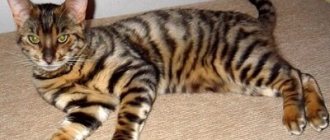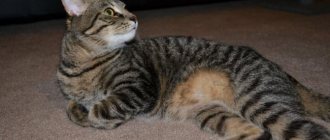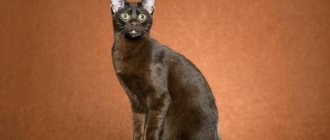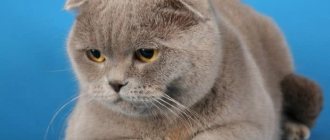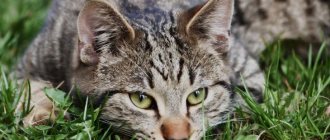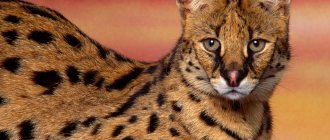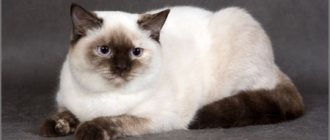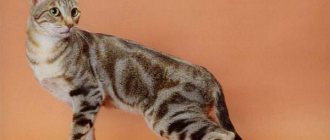History of the Isle of Man Cats
The Manx cat breed was formed naturally on the Isle of Man, hence the name. However, some are still inclined to believe that their place of origin is the Far East. Cats came to Europe in 1588 by sea. According to another version, the rat-catcher cat got from the ship by sea to the Isle of Man.
Manx feels like plush
In fact, it is difficult to indicate the exact version. The Manx breed has been spotted in many parts of the world, including Malaysia, Russia and China. There are versions according to which cats first appeared in Japan, since it was there that almost tailless bobtail cats arose.
The following legend is also connected with the origin story: the Manx cat was very curious, and on the way to Noah’s Ark, she was constantly distracted, which is why she came running to the ship last. Noah inadvertently pressed her tail when he closed the doors, and since then all representatives of this breed are born tailless.
However, difficulties in determining the place of origin do not prevent the inhabitants of the Isle of Man from being proud of “their” breed. These cats are symbols of good luck and the island itself. Their images can be found on coins, paintings and jewelry.
Although standards for this breed were described as early as 1901, the American Cat Association recognized it only in 1920. This was due to the fact that there were concerns about the instability of this natural mutation. However, after the cats were exported to the USA, and the mutation remained stable, the breed achieved recognition.
Health
Unfortunately, the gene responsible for the absence of a tail can also be fatal. Kittens that inherit copies of the gene from both parents die before birth and dissolve in the womb.
Since the number of such kittens is up to 25% of the litter, usually few of them are born, two to three kittens.
But even those Cymrics who have inherited one copy can suffer from a disease called Manx Syndrome. The fact is that the gene affects not only the tail, but also the spine, making it shorter, affecting nerves and internal organs. These lesions are so severe that kittens with this syndrome are euthanized.
But, not every kitten will inherit this syndrome, and its occurrence does not mean bad heredity. Kittens with such lesions can appear in any litter; this is simply a side effect of being tailless.
Usually the disease manifests itself in the first month of life, but sometimes it can drag on until the sixth month. Buy from nurseries that can guarantee you the kitten’s health in writing.
Appearance Features
Manx cats have developed muscles and a rich palette of colors. However, within the breed, several varieties are distinguished depending on the presence and absence of a tail: tailless (Dimple rumpy), with a small stump slightly hidden by hair (Rumpy riser), with a half tail (Stumpy) and a tail of regular length (Tailed). Different tail sizes affect the cost of the animal.
Images of Manx were even placed on coins
Another feature of the Manx is their gait. They move more like rabbits than like cats. This gait occurs due to the fact that their hind legs are longer than their front legs. In addition, a large difference was noticed in the sizes of males and females. The first ones are large and muscular, but the cats are small and graceful.
At the exhibition, tailless Manx are more prized, but to get offspring, it is better to choose an animal with at least a small tail.
The Manx head is round, with well-defined cheekbones and a powerful chin. The ears are set wide apart, the eyes are large, round and located at a small angle in relation to the ears. Eye color depends on the coat and can be blue, green, yellow and orange. Heterochromia also occurs. The Manx has a double-layered and dense coat, with a soft and short undercoat. The wool feels plush to the touch.
Manx kittens look like fluff balls.
Description of the breed
global $ads_google;
//data-ad-slot=”2475549904″ $ads_google = empty($ads_google) ? false : true; ?> if ($ads_google == false) {?> $ads_google = true; ?> } ?> Like all breeds officially recognized by international felinological organizations, Manx cats have their own breed standard. It contains an external description of the animal, compliance with which allows you to participate in exhibitions and participate in selection:
- The head is large, round in shape without sharp corners. Wide cheekbones with pronounced cheeks. The skull is slightly elongated towards the crown and chin.
- Manx's nose is of medium length with a smooth transition, there is no stop. The lobe is small, usually pale pink in color.
- The eyes are large and necessarily slanted, that is, the outer corners should look towards the ears, and the inner corners should look towards the tip of the nose. Their color can be different, organically combined with the color of their coat.
- The ears of this breed are wide and set high on the head. Their tips may be slightly rounded or pointed. A distinctive feature of Manx cats is that if you look at the head from behind, the upper part of the head, together with the ears, resembles the shape of a saddle.
- The neck is muscular, but short. Therefore, the appearance of the cat resembles a cute fluffy ball.
- The body is medium in size and has rounded shapes. The sides are slightly retracted. The rear part is more massive than the front: the croup is round and voluminous. The chest is wide. A Manx cat should certainly look dense and stocky. The legs are strong and muscular.
- The coat can be either long or short. It does not fit tightly to the body, it is fluffy. Thanks to the undercoat, the appearance resembles a soft rabbit fur coat. A variety of colors are allowed, with the exception of Siamese, brown and lilac.
Contrary to popular belief, not all animals are tailless. The breed standards describe 4 possible options:
- Dimple rumpy - no tail at all;
- Riser (rumpy riser) - a short tail, almost hidden under fluffy hair;
- Stumpy - the tail is shorter than that of ordinary cats;
- Tailed(longy) – a full-fledged tail.
Only those representatives of the breed that belong to the first category are allowed to be shown at exhibitions. The rest are involved in breeding.
In general, Manxes are medium-sized cats, weighing between 3.5 and 5.5 kg.
Behavior of Manx cats
Manx are very active and run real races around the house. The absence of a tail does not negatively affect their balance. Moreover, these are real rock climbers. In your home, most likely, your pet will love high cabinets and shelves.
These are very active and inquisitive cats.
Manx are excellent hunters and fishermen. The family has affectionate and kind pets. They love water very much (more precisely, watching it). If there is no water nearby to watch, they can entertain themselves by pressing the flush button on the toilet. Or you can just turn on the tap for them and let them relax. If you leave the cat without attention, the pet may be offended.
Manx are quite friendly, but, of course, will not tolerate pulling on their whiskers, ears and tail, as these areas are very painful for them.
Care, nutrition
No special care is required. By nature, they are very clean and take care of their appearance. The short, smooth and soft coat should be brushed approximately once a week. This is necessary to remove fallen hairs. During the shedding period, like other cats, Manx cats need to be scratched daily.
Washing is carried out as needed, once every 3-6 months. You shouldn't do this too often.
Like other cats, they need to have their ears and teeth cleaned, natural discharge removed from their eyes, and their claws trimmed. They should also be vaccinated against viral infections, rabies, and given anti-worm medications.
Education and physical activity
Manx are calm and affectionate
These tailless cats are very inquisitive and intelligent. They are easy to train and can even fetch things, just like dogs. If you live in an apartment, they can be trained to walk on a leash. But the love of carrying objects also has a downside - Manxes love to hide their toys and, perhaps, a small “stash” will appear in your house, in one of its corners.
Manx are highly intelligent
Tray training won't be too difficult either. In general, kittens are trained by breeders, and subsequently it is enough to simply consult with them about which litter is suitable for them.
Character of the Burmese cat
If you think about who the Burmese cat is suitable for, then there are no exceptions. The oriental beauty wins the hearts of not only cat lovers, but also avid dog lovers who refuse cats because of their independent nature. The Burmese are characterized by friendliness and activity, which persist until old age.
The character of the Burmese cat is in many ways similar to the habits of dogs. They love to play with the ball and are very loyal to their owners. After a long life with a Burmese cat, it is increasingly difficult to explain how a furry pet differs from a dog, except for its appearance.
Burmese get along well with children and other animals. For a child, a cat quickly becomes a child's best friend, as it gladly takes part in his pranks and never lets out its claws when hugged too tightly. The animal's high intelligence allows it to get along even with birds. The pet quickly gets used to the members of its family and is equally supportive of each of them. Only jealous cat breeds or aggressive dog breeds that pose a danger to a kind pet will not be suitable for co-keeping.
The breed has an intolerant attitude towards loneliness. If your cat has to stay alone in the apartment for a long time, then be sure to give her some company to play together. Kittens and adult animals love to sit in their owner's arms, so be prepared to give them plenty of attention. And if boys show equal love to all family members, then girls prefer to choose only one favorite.
At home, the Burmese are always the center of attention. If you got this cat, then be prepared to see her golden eyes every second. Control of daily affairs is the direct responsibility of the tailed pet.
Burmese cats are able to detect any changes in the owner’s mood. To lift their spirits, they perform intricate somersaults, relieve irritation with their pleasant purring, or prefer to temporarily hide to allow the owner to be alone with his thoughts.
Manx care
Caring for Manx cats is easy.
You can resort to combing either daily or twice a week - depending on how much time you have. The rest of the care is not too different from the care of other breeds, since these cats are very clean: cleaning the eyes, ears (cotton swabs should be soaked in hydrogen peroxide, but do not get it too deep into the ear). In addition, you need to brush your teeth with a special brush, trim the transparent part of the claws and, of course, bathe. The latter can only be done in special cases or when washing is clearly needed, since Manx cats do not really like to wash themselves. To add comfort to your cat, it would be a good idea to purchase a scratching post and high-quality eating utensils. And in general, a personal corner will greatly please your pet.
Important: cats of this breed do not know how to group due to the lack of a tail, and therefore they need to be protected from falling from great heights.
Character
Manx cats are active, playful and very friendly towards humans. They are very patient and love to be aware of all the events happening in the house. Anyone can have a Manx, even families with several children. Cats get along well with them and can play and run around all day. Of course, since they do not have a tail, which in other cats is extremely sensitive, no one will drag them by this appendage or try it on their teeth.
The absence of a tail does not allow cats of this breed to move imposingly, as other cats do. Due to this feature of the body structure, the Manx can only move in small leaps, but everyone will enjoy watching it.
In addition, the absence of a tail prevents such cats from falling correctly, so it is necessary to ensure that the pet does not climb too high and does not fall from a height on its own.
Maine residents bred cats not only for their friendly nature, but also for their excellent hunting qualities. Today, representatives of this breed are excellent hunters and can please the owner by bringing him a strangled mouse or bird.
In addition, these cats really love to look at the water, apparently this is an echo of the call of their ancestors who sailed to Maine on ships. However, this does not mean at all that the Manx will get into this water, most likely not. Like most domestic cats, they do not like water.
Feeding
Manx cats are unpretentious when it comes to food, but when feeding it is important to take into account that not all foods are suitable for them (especially when it comes to a diet made up of natural products). If you prefer food, it is better to choose super premium food, since it contains all the vitamins and minerals the animal needs.
The breeder can tell you what food the kitten is used to.
When feeding kittens, you need to add more foods containing phosphorus and calcium to the diet, since the offspring of Manx cats grow very quickly and by six months they are the size of an adult cat. Kittens up to four months need to be fed four times a day, up to ten months - three times, and adults - in the morning and evening. It is important to choose high-quality dishes for feeding and provide your pet with access to clean water.
You should not feed your Manx food from your table - this can have a bad effect on their digestion.
Care and maintenance of a Manx cat
Care is not particularly difficult, since these friendly cats are also unpretentious to their living conditions. But it is still necessary to take care of your pet, paying special attention to its fluffy fur. To do this, he needs to be combed once a week and bathed as needed.
In general, the animal is clean and can handle dirt on its own, but a periodic bath will help get rid of unnecessary hair. Hygiene also includes cleaning the ears and treating them against parasites that can easily take a liking to a fluffy coat. Manx cats are not picky about food either - it can be either natural or dry. The main thing is that it is of acceptable quality.
Manx diseases
The main danger for cats from the Isle of Man is a possible genetic mutation, so usually kittens are not released from the nursery until 4 months of age, while the formation of the body is observed. All animals require a routine examination by a veterinarian, because there is a risk of developing inflammatory skin diseases, as well as disorders of the intestines, genitourinary system and musculoskeletal system.
Manx cats live on average 11-15 years.
Conclusions about the breed
global $ads_google;
//data-ad-slot=”2475549904″ $ads_google = empty($ads_google) ? false : true; ?> if ($ads_google == false) {?> $ads_google = true; ?> } ?> Manx, in addition to their unusual appearance, have a wonderful character and get along well with others. Caring for them does not require much work, and is amply compensated by the affection and sincere affection of the animal. People from the distant foggy island today live in many houses around the world. The only difficulty of the breed lies in genetic mutations, which, in addition to the lack of a tail, can lead to health problems. Therefore, when purchasing, you should trust only experienced breeders and nurseries.
What diseases are typical for Manx cats?
In general, Manx cats are in good health, however, due to their body structure and taillessness, there are some breed-specific illnesses. This is Manx syndrome/Manx syndrome, in which the kitten’s spine grows slower than its body (the kittens die very young); congenital spinal hernia (leads to neurological disorders of the body); dystrophy of the hip joint (pathology of the hind limbs); dysfunctions of various kinds associated with the intestines and bladder, as well as corneal dystrophy (a genetic disease that does not affect general health). Many of the diseases appear at an early age.
Manx cats have good immunity
Unfortunately, such diseases cannot be dealt with on your own, but common diseases to which any cat is susceptible can be avoided by monitoring the pet’s hygiene, conducting regular preventive examinations and treating it for parasites (even if the pet is at home all the time and it would seem , out of nowhere).
Mister Cat warns: possible health problems
The genetic characteristics that provide the characteristic differences of the breed also cause diseases characteristic of Manx cats. First of all, this is Manx syndrome, from which kittens often die before reaching 4 months.
These cats are also prone to the following diseases:
- dystrophy of the cornea of the eye (discovered in infancy);
- pathologies of the bladder, various parts of the intestines;
- pyoderma (inflammatory and purulent process that affects the back of the cat’s body);
- weakness of the limbs, coordination disorders;
- spinal hernias.
On average, Manx cats live 10-15 years.
Breeding
Before starting breeding, you need to consider some features. For example, puberty in Manx cats occurs by the age of three, so adulting will need to wait a little longer than is the case with ordinary cats. At the same time, you should not arrange a date for two rampies, that is, tailless Manx, since the chances of survival of the offspring are reduced (longhairs or European shorthairs are more suitable for rampies). With proper crossing, however, kittens of any of the named subspecies can be born (individuals born with a tail are recommended to have it docked immediately to avoid health problems). Ideally, no more than four kittens are born. If the cat’s closest relatives had more numerous offspring, the pregnant woman needs careful monitoring and care, since there is a possibility of death of both the fetus and the mother.
A couple can have up to four healthy kittens.
You need to approach the selection of a partner for mating wisely and it is better to contact the breeder, and if this is not possible, contact a felinological organization available to you. The process should take place on the territory of the male, for his fuller confidence, after which the cat should stay with him for a few more days. They are introduced on the third day of estrus. At the same time, when you bring the expectant mother for mating, you need her to come out of the carrier to the new territory. It is desirable that young individuals interact with more experienced ones.
Appearance standards
This breed is often jokingly compared to rabbits, since their hind legs are longer than their front legs, and therefore they move with a slight hop. Together with their short tail, this makes them look like hares. The Manx cat is different in appearance:
- strong, rectangular, strong body of medium size;
- medium-sized rounded head;
- pronounced cheeks;
- strong chin;
- rounded forehead;
- medium ears, wide at the base (may be present at the tips of the brush);
- eye color, which must be combined with the shade of the coat;
- muscular legs proportional to the body;
- arched back;
- developed undercoat and thick coat.
It has been noted that cats are always larger than cats. In this case, literally any colors can be present, the coat can be short - this is a purebred Manx cat, or long - this is the Cymrik subspecies. Show-class animals are characterized by the absence of a tail as such, although the standards allow the presence of several spinal cartilages. But such animals are given low marks.
Sterilization and castration
Sterilization and castration will greatly simplify life for you and your pet (unless, of course, you plan to breed Manx cats), at least by the fact that the cat will not constantly mark the territory in your house, and the cats will not suffer and loudly call for the male during the period of heat. By the way, after such a procedure, the animal will remain kittens longer, up to the age of five. Males should be sterilized at nine months of age, and male cats before their first heat, but it is still best to consult a veterinarian.
Sterilization does not harm animals
The procedure itself is simple, but the rehabilitation period is very important. When waking up from anesthesia, you need to dim the light so that it does not blind the pet, then give some water (you can use a syringe), and, on the third day, switch to feeding soft food. It is also important to constantly inspect the seams. If redness, leakage or swelling appears, you should immediately consult a doctor.
Cost of a kitten
The breed is quite rare, which leads to its high cost. Finding a kitten in Russia is quite difficult, since there are no nurseries or breeders in our country.
You will have to purchase a kitten abroad, so prices for kittens start at $450-500. In addition, transportation costs will be required.
When purchasing, you should keep in mind that not all Manx cats are tailless; a cat may have a short tail or even a normal length. You should also carefully study the breeder's recommendations; it is advisable to consult a veterinarian, since not all kittens without a tail belong to this particular breed.
The lack of continuation of the spine may be the result of injury or artificial amputation made by an unscrupulous seller.
Manx cats are an extremely rare breed, but if you buy a kitten and overcome numerous difficulties, you can get a true friend and a favorite of the whole family, because these cats are extremely peaceful and friendly.
Manx photo gallery:
Pros and cons of the breed
Adorable four-legged friend
The Manx is a rare breed characterized by high intelligence, ease of care, great adaptability, good health and friendliness. However, some advantages also come with disadvantages. For example, due to the rarity of the breed, the cost of kittens is quite high, and it is difficult to find partners for breeding. In addition, Manx breeds are few in number, and many have health problems, which is why some kittens are either stillborn or die after birth.
Advantages and disadvantages of the Manx breed
The Manx breed has many advantages, but there are also disadvantages. Whether you are ready to become the owner of such a cat is, of course, up to you to decide.
Table: comparative characteristics of Manx cats
| Advantages. | Flaws. |
| A rare breed of great value among cat lovers. | Problems in purchasing and high cost of kittens. |
| A beautiful animal, suitable for the role of a good companion for any family. | Difficulty in finding partners for breeding the breed. |
| He is highly intelligent and well trained. | Few offspring and a large number of discarded kittens for medical reasons. |
| Does not have big problems with maintenance and care. | |
| Easily adapts to any place of residence and can provide protection from rodents in your home. | |
| Has a good level of health. |

